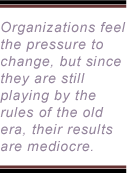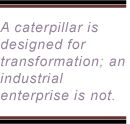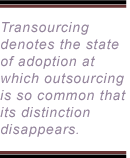About/Disciplines and Origins
 Transourcing™ is not really about outsourcing at all. It is a transformation approach that enables companies to create a sustainable competitive advantage by capitalizing on trends that are shaping the Knowledge Economy. The term represents an attempt to bridge the current state reality of most enterprises in 2006 with a future state in which their structures are transformed from relatively self-contained organizations to networked global organizations. "Outsourcing" is a very limited term, but it is useful because, seen from the perspective of the current state, it is a practical way to achieve profound transformation incrementally—and profitably. Transourcing™ is not really about outsourcing at all. It is a transformation approach that enables companies to create a sustainable competitive advantage by capitalizing on trends that are shaping the Knowledge Economy. The term represents an attempt to bridge the current state reality of most enterprises in 2006 with a future state in which their structures are transformed from relatively self-contained organizations to networked global organizations. "Outsourcing" is a very limited term, but it is useful because, seen from the perspective of the current state, it is a practical way to achieve profound transformation incrementally—and profitably.
Outsourcing today is at the stage of adoption that e-business was in 1996. The potential of outsourcing is difficult for most leaders to appreciate because it doesn't feel new; everyone has done it for decades or longer. The difference today is that ongoing e-business adoption and globalization have continuously increased collaboration capabilities, tremendously expanding the scope of the outsourcing value proposition. The fact that most of your competitors are practicing outsourcing with an 80s rule book can enable you to seize the advantage.
Making Transformation Practical
Transformation represents a mixed proposition for executives of 20th century organizations.  In general, organizations at the end of an era increasingly feel the pressure to change, but since they are still playing by the rules that made them successful in the old era, their results are often mediocre. Executives and employees alike get the feeling that change is being imposed on them because they don't feel in control. However, when leaders understand the new rules and start winning, they transform their experience with change itself. They feel more in control and obtain far better results, and change as a process becomes more rewarding. They are able to align their strategy with the environment, so their decisions are more appropriate and more impactful. In general, organizations at the end of an era increasingly feel the pressure to change, but since they are still playing by the rules that made them successful in the old era, their results are often mediocre. Executives and employees alike get the feeling that change is being imposed on them because they don't feel in control. However, when leaders understand the new rules and start winning, they transform their experience with change itself. They feel more in control and obtain far better results, and change as a process becomes more rewarding. They are able to align their strategy with the environment, so their decisions are more appropriate and more impactful.
The emotional underpinnings of change aside, it is very difficult to transform an entity that is not designed to be transformed. A caterpillar is designed for transformation; the industrial enterprise is not. Transourcing™ is designed to guide organizations not designed for change through transformation. Its methods focus on achieving transformation iteratively, and they produce incremental business benefits. The transformation end state will be 5-10 years in the future for many organizations, so the only transformation that will work for them is an approach that produces significant incremental business benefits.
A Multidisciplinary Approach
Transourcing™ integrates the practice of outsourcing with the transformational disciplines of corporate strategy, knowledge management, innovation strategy, object-oriented software development and leading edge marketing/design:
- Corporate strategy contributes the discipline of analyzing and understanding where the organization is currently as well as where it wants to go and its plan to get there. It answers the questions of what business the company is in, why it is in that business, and how it creates and delivers sustainable, distinctive value for customers.
- Knowledge management is an approach that seeks to digitize highly evolved information that is integral to sustainable transformation. "Information" has to be selected, created, organized, packaged and delivered in order to become knowledge. Its most important contribution is its explicit discipline for building capability through sharing knowledge and measuring the impact of knowledge sharing.
 Innovation strategy is a process by which organizations develop a core competency in innovation so that they consistently and repeatedly outperform competitors in bringing new offerings, processes and models to market. In the Industrial Economy, product life cycles were long, and innovation was practiced rarely. Consequently, very few companies know how to innovate. In the Knowledge Economy, product life cycles shrink, and innovation will be key to survival. To consistently produce breakthrough ideas, companies will have to create collaborative processes that draw from diverse points of view. Crowdsourcing is an emerging, extreme example of this. Innovation strategy is a process by which organizations develop a core competency in innovation so that they consistently and repeatedly outperform competitors in bringing new offerings, processes and models to market. In the Industrial Economy, product life cycles were long, and innovation was practiced rarely. Consequently, very few companies know how to innovate. In the Knowledge Economy, product life cycles shrink, and innovation will be key to survival. To consistently produce breakthrough ideas, companies will have to create collaborative processes that draw from diverse points of view. Crowdsourcing is an emerging, extreme example of this.- Object-oriented software development is transformational when seen in the context of legacy software development—in two key areas. 1) The design of the software itself manages complexity and risk by imitating the natural world: Specialized functions are encapsulated within cells, which communicate with each other using standardized methods. This manages complexity: cells don't have to know what's going on inside each other; they need only know what each other does and, if relevant, how to access each other's "services." Unlike the natural world, software requires a strategy for how activity is "chunked" into "objects" (the cells of software) as well as a standardized messaging design, and these are defined through software "architecture." Due to encapsulation and standardized messaging, it is termed "loosely coupled" because it is easy for objects to communicate with each other, and the whole is very flexible and robust. 2) The way in which software professionals build and change software is markedly different from the "traditional" (waterfall) development: it emphasizes collaboration, among software professionals as well as between them and their clients. It features short development cycles and frequent deliverables. A vital part of collaboration is mentoring and knowledge transfer.
- Marketing as a discipline itself faces transformation, but it offers significant insights, methods and processes for creating customer experience. Transourcing™ recognizes that a major thread of innovation will be the explicit creation of rewarding customer experiences, and the marketing discipline, once it sheds numerous legacy "push/mass" marketing assumptions, will be a major contributor. Much of the enterprise's transformation will involve engaging customers to collaborate with the enterprise to create rewarding experiences for themselves by using its products and services as "props." Marketing has served the industrial enterprise and, as such, has been focused on creating demand for products that have already been made where, in the 21st century, products and services will be secondary in importance to experience. This will be increasingly possible due the rapid technology-enabled, growth of real-time customer information.
How and Why It Came About
 Transourcing™ is the brainchild of Christopher S. Rollyson, and it includes extensive research and input from experts in business and software architecture, outsourcing, innovation strategy, knowledge management and corporate strategy. Numerous CIOs and other corporate executives have generously given their input. Transourcing™ is the brainchild of Christopher S. Rollyson, and it includes extensive research and input from experts in business and software architecture, outsourcing, innovation strategy, knowledge management and corporate strategy. Numerous CIOs and other corporate executives have generously given their input.
Chris has had leading roles with the adoption of several of today's well established management practices and technologies like Java, service-oriented architecture, Web services and e-business. He sees outsourcing as a practical step toward business process mastery and the evolution of the globally networked organization, which will engage and disengage resources and expertise around the world on demand. In his transformation work, Chris has helped to create distributed organizations through several evolutionary phases:
- Enterprise software, for most of its existence, has had a self-contained, tightly coupled structure that was never designed for interactivity except in limited, highly defined circumstances. During the past 15 years, this software has been transformed in small steps with object-oriented technology. Today, it can increasingly deliver, without expensive custom integration, highly granular information to anyone via standards-based technologies like Web services.
- E-Business applied the Internet to business practices, albeit in a superficial way (relative to today). Because the network (Internet) was standards-based, anyone with a browser could access information, which meant that customers, partners could service themselves. This led to the rise of asynchronous communications, and it has begun to transform business processes. With it, the global organization had a new way to make itself more distributed.
- Deep business process mastery and digitization is the next logical step in business transformation. As we have standards-based, loosely coupled technologies that interoperate today, we will have standards-based, interoperable business processes in the future. Organizations that focus on business process digitization and mastery will be better prepared to profit from this transformation.
Outsourcing is poised for significant growth as an enterprise core competency, similar to Java, e-business and service-oriented architecture. A key insight for Transourcing™ is applying principles from object-oriented (OO) development to the business structure of the organization rather than software. OO software is built in stages, which can deliver significant incremental benefits. Therefore, Transourcing™ features short cycles, frequent deliverables and a reliance on business architecture to integrate focused, discrete projects into a cohesive whole.
About Christopher Rollyson
Christopher S. Rollyson has been a pioneer in enterprise transformation for over fifteen years, with distinction in corporate strategy and innovation. Recently the Vice President of Marketing at nVISIA, he developed executive marketing programs and service offerings to drive the value of software transformation through service-oriented architecture and Web services. Previously a subject matter expert for e-business and knowledge strategy in PricewaterhouseCoopers' Strategic Change practice, Mr. Rollyson developed original models and services frameworks for e-business strategy consulting. He consulted to clients in automotive, software, telecoms, consumer electronics, chemicals and petroleum industries, advising global enterprises in e-business strategy and technology start-ups on innovation and business strategy. Prior to PwC, he led marketing for KPMG's Midwest High Technology practice, where he built one of the firm's first intranets to transform the marketing organization to a real-time team. Before that the head of marketing at a leading edge Java consultancy, he played a key role in co-launching Java via marketing alliances with Sun and Netscape. Mr. Rollyson has done graduate work in strategy and economics at the University of Chicago, with additional studies at Die Freie Universität Berlin and L'Université de Clermont-Ferrand in France. He earned his undergraduate degree from Kalamazoo College.
Read a full bio here. Resume here.
| P.O. fuses several proven technology and management approaches into a dynamic comprehensive transformation process. |
|



 Transourcing™ is not really about outsourcing at all. It is a transformation approach that enables companies to create a sustainable competitive advantage by capitalizing on trends that are shaping the Knowledge Economy. The term represents an attempt to bridge the current state reality of most enterprises in 2006 with a future state in which their structures are transformed from relatively self-contained organizations to networked global organizations. "Outsourcing" is a very limited term, but it is useful because, seen from the perspective of the current state, it is a practical way to achieve profound transformation incrementally—and profitably.
Transourcing™ is not really about outsourcing at all. It is a transformation approach that enables companies to create a sustainable competitive advantage by capitalizing on trends that are shaping the Knowledge Economy. The term represents an attempt to bridge the current state reality of most enterprises in 2006 with a future state in which their structures are transformed from relatively self-contained organizations to networked global organizations. "Outsourcing" is a very limited term, but it is useful because, seen from the perspective of the current state, it is a practical way to achieve profound transformation incrementally—and profitably.  In general, organizations at the end of an era increasingly feel the pressure to change, but since they are still playing by the rules that made them successful in the old era, their results are often mediocre. Executives and employees alike get the feeling that change is being imposed on them because they don't feel in control. However, when leaders understand the new rules and start winning, they transform their experience with change itself. They feel more in control and obtain far better results, and change as a process becomes more rewarding. They are able to align their strategy with the environment, so their decisions are more appropriate and more impactful.
In general, organizations at the end of an era increasingly feel the pressure to change, but since they are still playing by the rules that made them successful in the old era, their results are often mediocre. Executives and employees alike get the feeling that change is being imposed on them because they don't feel in control. However, when leaders understand the new rules and start winning, they transform their experience with change itself. They feel more in control and obtain far better results, and change as a process becomes more rewarding. They are able to align their strategy with the environment, so their decisions are more appropriate and more impactful.  Innovation strategy is a process by which organizations develop a core competency in innovation so that they consistently and repeatedly outperform competitors in bringing new offerings, processes and models to market. In the Industrial Economy, product life cycles were long, and innovation was practiced rarely. Consequently, very few companies know how to innovate. In the Knowledge Economy, product life cycles shrink, and innovation will be key to survival. To consistently produce breakthrough ideas, companies will have to create collaborative processes that draw from diverse points of view. Crowdsourcing is an emerging, extreme example of this.
Innovation strategy is a process by which organizations develop a core competency in innovation so that they consistently and repeatedly outperform competitors in bringing new offerings, processes and models to market. In the Industrial Economy, product life cycles were long, and innovation was practiced rarely. Consequently, very few companies know how to innovate. In the Knowledge Economy, product life cycles shrink, and innovation will be key to survival. To consistently produce breakthrough ideas, companies will have to create collaborative processes that draw from diverse points of view. Crowdsourcing is an emerging, extreme example of this. Transourcing™ is the brainchild of Christopher S. Rollyson, and it includes extensive research and input from experts in business and software architecture, outsourcing, innovation strategy, knowledge management and corporate strategy. Numerous CIOs and other corporate executives have generously given their input.
Transourcing™ is the brainchild of Christopher S. Rollyson, and it includes extensive research and input from experts in business and software architecture, outsourcing, innovation strategy, knowledge management and corporate strategy. Numerous CIOs and other corporate executives have generously given their input.